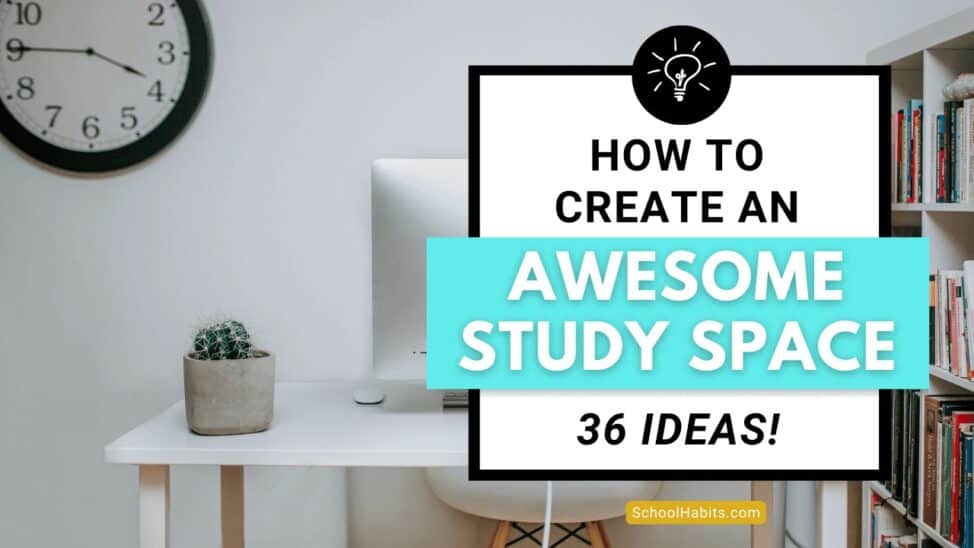
By Katie Azevedo, M.Ed.
This post offers 36 ideas for how to create a study space that’s awesome. Some tips are better suited for college or university students, and some are for middle and high school students. Some tips will help you design your personal study space, and some will help you set up a portable study space if you’re temporarily studying in a different location or public place.
36 ideas to create a study space that’s awesome
Your study space should inspire you and support the work you’ll be doing there. If your study setup needs a revamp (it probably does), try out some of the suggestions below.
1. Have a home base study area
Whether you live in dorm room or at home, you need a designated place to study. This should be an area of your room or house that doesn’t need to be packed up and put away each time you need it. You don’t need a large space; you could even use a sturdy folding table or the inside of a converted closet.
2. Have a go-to satellite study spot
Occasionally changing up your study location is a good idea and can increase motivation. Identify one spot that can be your satellite study space: a library nook, a random nook in another academic building, or a coffee shop. Here are some more ideas.
3. Incorporate a visible time element
Have a standalone clock (mandatory) and cube timer (optional) on your desk. Do not rely on your phone clock, because your phone should not be on your desk while you are working or studying.
4. Use a quality chair
Your chair should be more functional than decorative. Here are some instructions for adjusting your chair for optimal posture.
5. Soften your space with a blank or pillow
Your study space should not be too comfortable or it will promote sleep instead of focus. But softening your space with a throw blanket or pillow on your chair can make your spot more inviting.
6. Have sufficient desk space on the left or right side
While you don’t need a large desk to work, you do need sufficient surface space on either the right or left side of your keyboard. You need this space for your open textbooks, notebooks, and other materials.
7. Use a scratch pad (inbox)
Keep a medium-sized scratch pad open on your desk while you study. As distracting thoughts arise, write them down. As new to-do items pop into your head, write them down.
8. Match your study space to your learning style
If you’re strongly a visual, auditory or kinesthetic learner, then consider incorporating elements into your study space that support your unique characteristics. Below are full study space tutorials for each learning preference.
9. Have a spot for everything
Everything in your study area should have a location, and you should return each item to its location when you’re done studying. If you have random items on your desk that don’t have a home, either find a home for it or reconsider whether you need the item in the first place.
10. Keep important items no more than 2 touches away
Store items that you frequently reach for no more than two touch-points away. For example, store pens inside a drawer, but not in a closed box inside the drawer (too many touches). Items that you use less frequently can be stored differently.
11. Identify and reduce friction
Your study space should work for you. It should inspire you and support your work and study habits. If any part of your study setup annoys you or prevents you from working productively, change it. Do you constantly reach for an icky pen? Get rid of it and only keep pens you like. Do you have paper piles on your desk that stress you out? Improve your paper system. (idea # XX)
12. Use Status Notes
Status Notes are an excellent way to make sure you pick up where you left off, anytime you have to stop in the middle of a task or project before you’re done with it. Here’s how to use Status Notes.
13. Use the right lighting
Lighting can make a huge difference in our mood and motivation. Depending on your situation, you may not have much control over your overhead lighting, but you can enhance your ambient lighting with a well-placed desk or table lamp.
14. Keep basic office supplies handy
Stock your study space with basic work and school supplies like the following:
- Calculator
- Index cards
- Stapler
- Whiteout
- Tape
- Pens and pencils
- Various types of paper
- Sharpies
- Index cards
15. Set up near a window
Natural light enhances mood, and a good mood can increase motivation and productivity. If possible, position your desk near a window. Avoid heavy drapery to maximize light flow.
16. Keep surface items minimal
It’s important that your study space reflects your unique personality, but keeping 10 Mickey Mouse figurines on your desk is bad for focus. Also, the more items you have on your desk, the harder it is to clean the surface. Here’s what you need to know about keeping your things clean.
17. Use a wall calendar and/or whiteboard
Hanging a wall calendar and/or whiteboard near your desk has several benefits:
- It’s a visual trigger that indicates the space is for studying and working
- Wall calendars are great for date-sensitive information, like due dates, tests, and days off
- Whiteboards are good for brainstorms, reminders, and important information
18. Keep a trash barrel nearby
To help keep your space clear and clutter-free, you should be able to throw something away in the trash barrel without getting up from your chair.
19. Choose soft-noise locations when studying off-base
Some of us thrive in pure silence, while others prefer some soft background noise when studying. If you don’t want pure silence for your study session away from home, set up in a coffee shop, book store, or other location that has muted, indistinguishable chatter in the background. Here’s a popular YouTube recording of over an hour of coffee shop noises if you can’t get yourself to a real coffee shop.
20. Create a portable study-space bag
When you want to switch up your study spot for a day, it’s important to remember to bring all the right supplies with you. That’s why I suggest you create a portable study space bag with all your study essentials. If possible, keep these items permanently stored in a pouch or bag, and keep them separate from your regular desk materials. That way, you can just grab and go.
21. Have a paper system
Paper clutter is bad for focus. It’s also just bad organization. Make it a regular practice to sort through paper piles, put papers where they belong, and not throw papers on your desk in the first place. If you’re unsure what to do with old school papers, then here are my tips for properly storing old school papers.
22. Put a rug under your chair
Nothing says “cozy” like a rug under your feet. Rugs are also good for absorbing sound, which is important for focus and for online classes.
23. Use a charger/wire basket
Idea #9 suggests having a spot for everything. This includes chargers, wires, and other tech. Store these items in a small open basket near or under your desk.
24. Remove the following from your study space:
- Phone
- Trash
- Messy snacks
- Items not related to studying
- Clutter
- Noise distractions (people, TV, etc.)
- Old, broken or unused tech
25. Stick to a color scheme
This is totally optional, but consider sticking to a color theme. Unifying your study area with a common color can inspire and motivate visually-inclined people.
26. Store binders and books vertically
If desk and storage space is limited, store books vertically with their spines facing out. You can keep the books standing upright with simple bookends.

27. Store headphones on a hook
You could store your headphones in your tech basket (Idea #22), but if your headphones are fragile, store them on a command hood near or under your desk.
28. Combine function with personality
Your study space design should first be about function (does it work? Do I need it? Is this easy?), and then second about personality (do I like it? Does it bring me joy?). It’s the sweet spot when one item or design feature does both at the same time.
29. Put a bookshelf next to your desk to keep your desk neat
If your desk doesn’t have drawers, put a small bookshelf next to your desk.

30. Use a desk pad
If your desk surface is beaten up (hellooooo dorm room desks!), cover the wickedness with a desk pad. You can get a calendar desk pad or something like this one. An added benefit is that writing on a desk pad makes your penmanship smoother.
31. Raise your monitor
Make sure your monitor is at the right height. If not, raise it. You can use a storage box you have laying around, or you can get a simple stand like the one I use at home.
32. Utilize wall space with shelves
Most study spaces are small – whether a dorm room desk or a corner of a bedroom at home. Therefore, look to the walls for additional storage. You can install simple shelves on your walls to store lightweight items that would otherwise clutter your desk.
33. Use a pop-up post it note dispenser
All good study spaces should be equipped with sticky notes. Consider using a pop-up dispenser like this one.
34. Keep common reference materials nearby
Keep regularly consulted reference materials (like your schedule, a period table, a phone contact list, or a syllabus) nearby or tacked to a corkboard.
35. Be mindful of the temperature
If your study area is cold, get a space heater. If it’s too hot, get a fan. This study about temperature by Cornell University is enlightening.
36. Ensure your audio and visual set-up is solid
Most computers come with basic cameras and speakers, but if you’re spending a lot of time on Zoom or online classes, you might want to invest in audio and visual equipment that’s one level up. If you’re on camera, make sure that you turn off any lights behind you or close the shade if a window is behind you: it’s a best practice to keep your light source in front of you, shining on your face.
Final notes about how to create a study space that’s awesome
I hope these ideas about how to create an awesome study space inspire you to look at your current environment and tweak it to make it work better for you. When you sit down to study, your space should lift you up and support your focus; if it doesn’t, then change something. If you’re looking for more organization inspiration, check out my 100 school and study organization tips.

